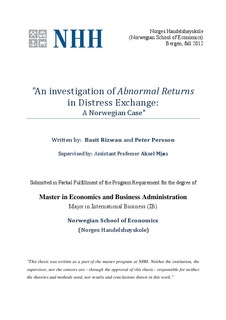| dc.contributor.author | Rizwan, Basit | |
| dc.contributor.author | Persson, Peter | |
| dc.date.accessioned | 2013-02-19T11:34:24Z | |
| dc.date.available | 2013-02-19T11:34:24Z | |
| dc.date.issued | 2012 | |
| dc.identifier.uri | http://hdl.handle.net/11250/169919 | |
| dc.description.abstract | The main objective of this research is to investigate whether distress firm creditors get better
or worse recoveries during the financial restructuring process in Norwegian Bond market. To
investigate that question we have created a sample using Norsk Tillitsmann database. For the
criterion we needed firms in the data sample that went through financial restructuring due to
financial distress or financial. We managed to get hold of ninety seven bonds using the above
criterion. The sample was composed of different classes of bonds according to their seniority,
but majority was senior secured and senior unsecured bonds. We have also divided the sample
into five broader industry classifications and the majority of the sample firms were oil and gas
related.
During the literature review process we came up with a few hypotheses and tried to find
evidence of them in the sample. For this purpose we conducted a layman analysis, i.e.
descriptive analysis in which we came to conclusion that creditors are better off if the
borrower is in oil and gas industry and if they hold senior secured or senior unsecured
securities. We also found descriptive evidence that debt exchange produce higher “abnormal”
return for distress firm’s creditors than debt to equity swap.
Finally we conducted statistical tests on the sample to find the evidence of stated hypotheses
to see if the results are statistical significant or not. The results were not significant to the
hypothesis that seniority and collateral leads to higher abnormal returns; however there are
strong indications that the industry as well as debt exchange or equity swap are relevant
factors for higher abnormal returns.
Also examined was if bondholders recoveries are being affected by the gearing (leverage) of
the distress firm and also by the time to maturity (settlement date) of the bonds. In regression
analysis we did not find both of these to be significant affecting bondholders’ returns however
we did notice that almost all of the firms had 66% to 80% debt in their capital structure. As
well we believed that high leverage is the reason for them to be in distress. In our sample of
there is one financial restructuring (Sevan Marine ASA) that stands out with the clear
violation of Absolute Priority Rule (APR), and there were other minor APR violation in not
so strict sense.
The final conclusion we drew from analyzing the sample is that a creditor’s or investor’s in
the Norwegian bond market should place themselves in the Oil & Gas industry and negotiate
for debt exchanges during restructurings process to get higher abnormal returns. | no_NO |
| dc.language.iso | eng | no_NO |
| dc.subject | international business | |
| dc.title | An investigation of abnormal returns in distress exchange : a Norwegian case | no_NO |
| dc.type | Master thesis | no_NO |
| dc.subject.nsi | VDP::Social science: 200::Economics: 210::Economics: 212 | no_NO |
| dc.subject.nsi | VDP::Social science: 200::Economics: 210::Business: 213 | no_NO |
